Diving into the world of issue tracking tools can resemble navigating your way through a labyrinth.
You may discover that there are so many high-quality issue trackers out there that it’s hard to settle on just one.
That is why we’ve curated this list of the top nine app issue tracking tools, complete with their advantages and disadvantages, price range, and key features, so that you can choose the one that will truly change how you handle issues.
Stay tuned to see what they are!
Table of Contents
Shake
Although you may be eager to jump into fixing bugs, glitches, and other defects in your code right away, first you need to detect them and send them to the dedicated issue tracker.
This is where our own solution, Shake, can make a world of difference.
This bug and crash reporting tool works with iOS and Android mobile devices, and brings a quantum shift when it comes to reporting issues.
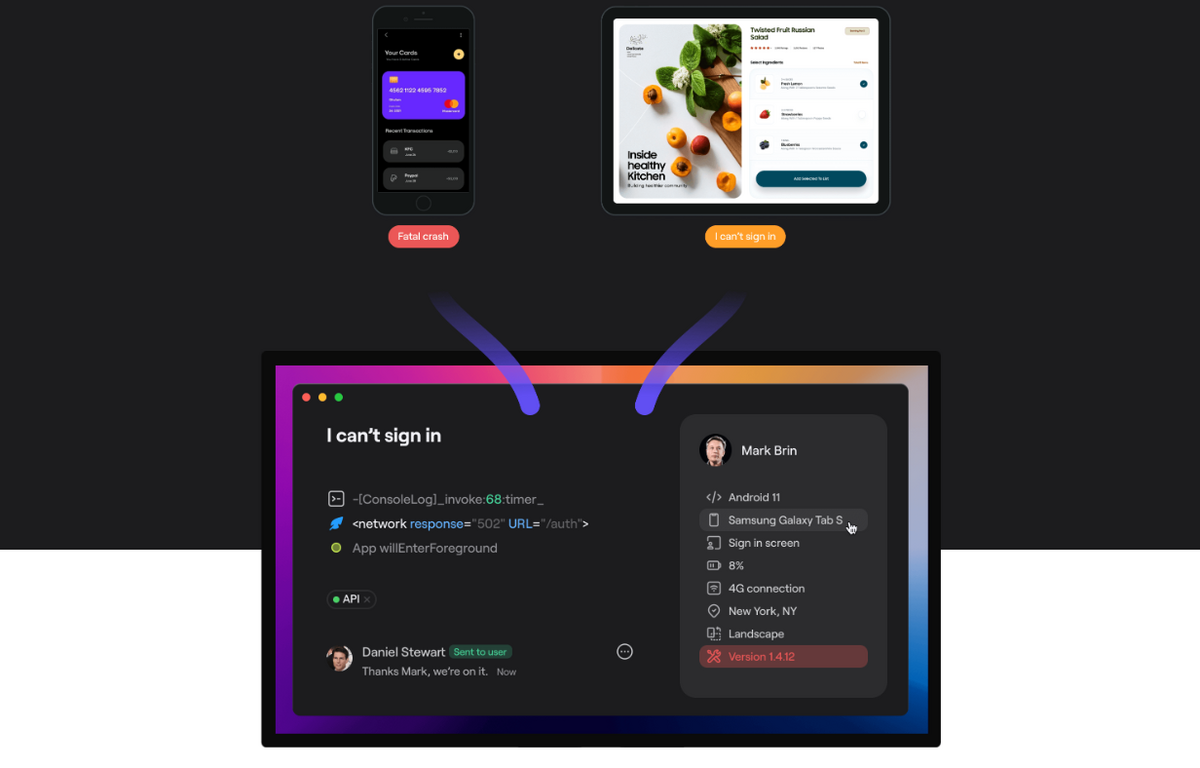
In other words, whenever a user or QA tester uncovers a bug in the application, they just need to give their mobile device a good old shake.
The tool will then automatically generate an elaborate bug report that contains more than 70 key pieces of data, including the device model and OS, app and network specifics, storage status, IDE version, and so on, as shown below.
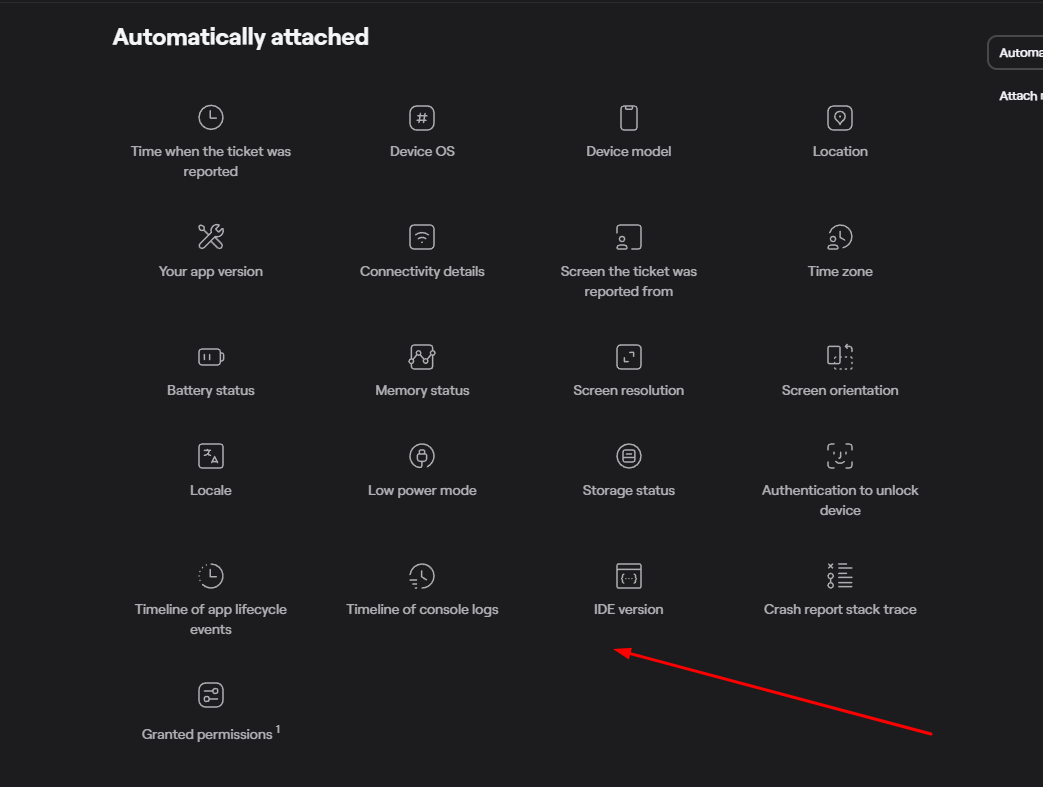
This is possible because Shake, just like airplanes, has a black box that records a detailed environmental profile, providing data on what happened to the application 60 seconds before it crashed or a bug was reported.
Moreover, Shake goes above and beyond by including screenshots and video recordings in the report, giving developers all the information and visual evidence they need to track and resolve pesky issues plaguing their app.

Get unreal data to fix real issues in your app & web.
In terms of pricing, Shake stands out as one of the most budget-friendly solutions on the market.
You can choose from three pricing models: Free, Premium, and Organization. The free tier lets you acquaint yourself with the tool before making a purchase.
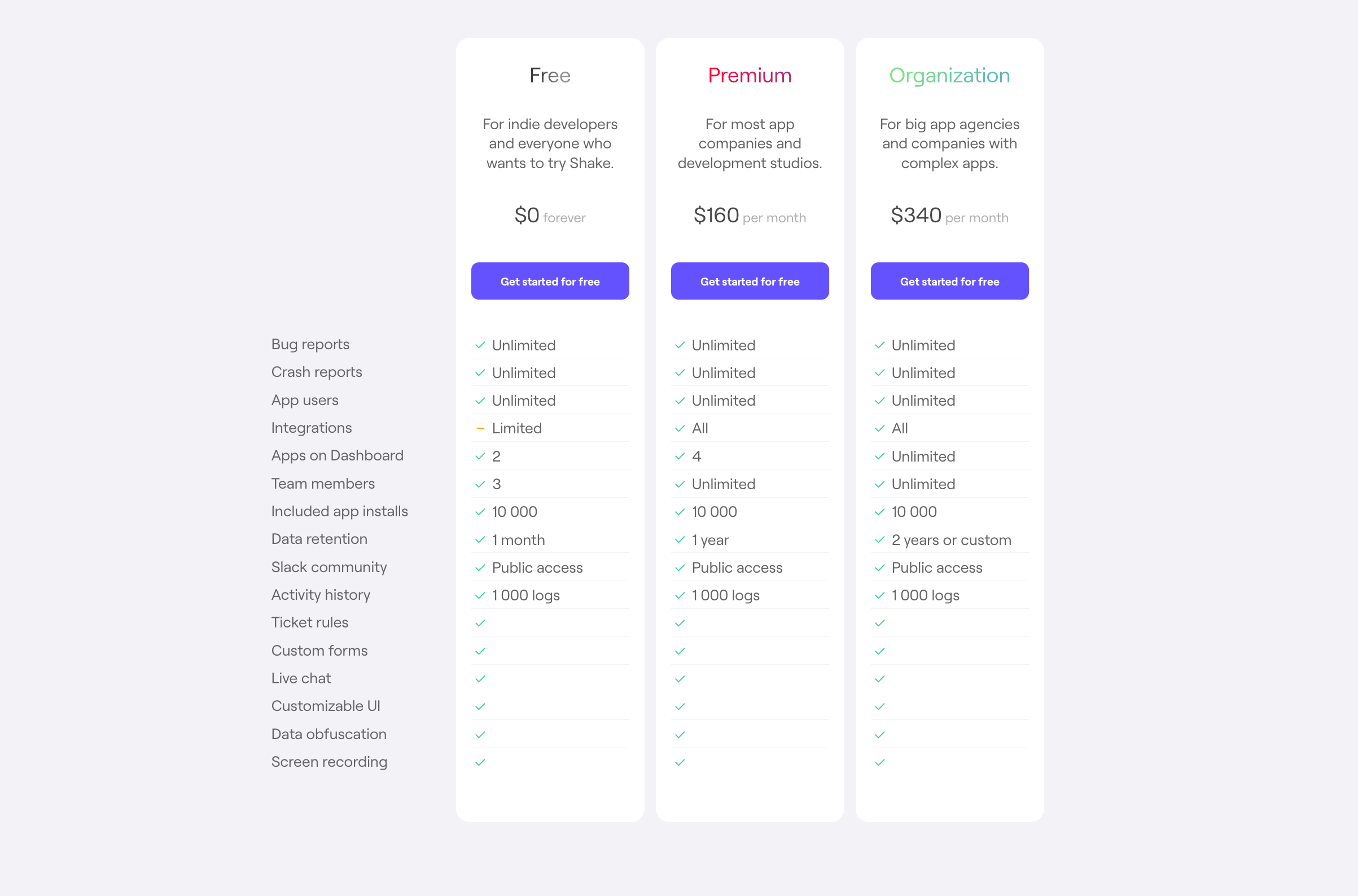
But what is bound to attract many potential users is the fact that Shake offers unlimited reports, which means the price remains the same no matter how many issues your team submits.
Moreover, each plan includes all features with no strings attached or sneaky surprises, making this one of the most honest and cost-effective bug and crash reporting tools available.
Backlog
The next tool on our list is Backlog, which may not be the foremost contender that springs to mind when you think of issue tracking, but it might surprise you with its practicality, affordability, and interesting features.
To begin with, Backlog is simultaneously a project management, version control, and issue tracking tool, meaning it solves three problems in one fell swoop.
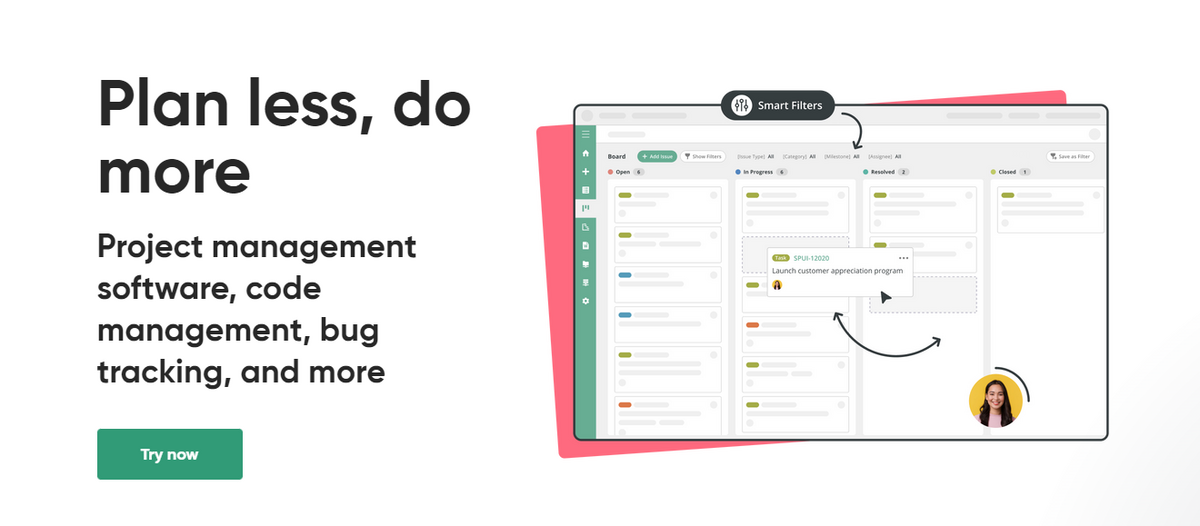
It’ll help you organize your projects, streamline your processes, and enable you to track issues throughout their entire lifecycle.
Additionally, with the help of built-in Git and SVN repositories, developers can directly link their code commits and pull requests to issues, as well as merge, build, and update everything within one centralized hub.
To keep everyone in the loop, Backlog offers Kanban-style boards that give your team a bird’s-eye view of every issue and task as they glide through the workflow.
There are also complementary features such as Gantt charts (shown below), file sharing, and a Wiki, which provide an additional visual presentation of issues, offer the ability to share different types of files between team members, and store all project-related documentation and guidelines in one place.
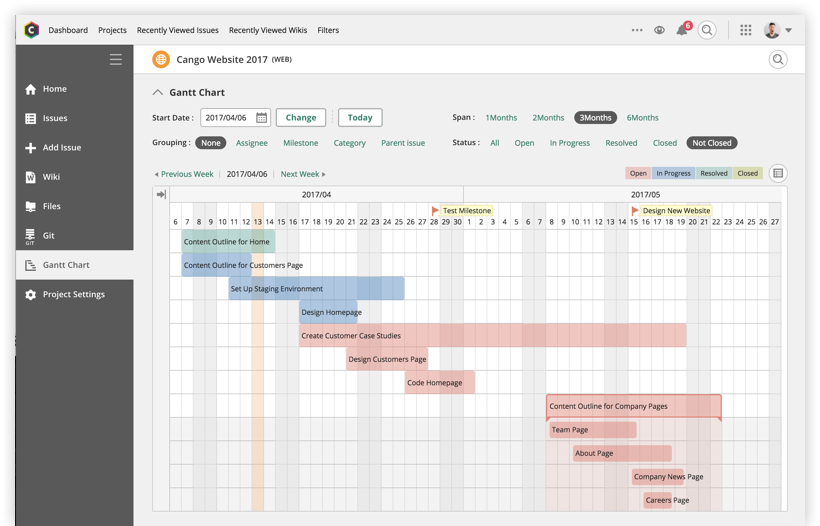
Although the issue-tracking arena is filled with heavyweights, the Goliaths of the industry, many development teams will choose this tool because, apart from all these features, it also offers competitive pricing plans.
You can select between Free, Starter, Standard, and Premium plans, and thanks to the ability to explore the tool for free, you have ample time to try out its basic features and see if it’s what your team needs.

Of course, no tool is perfect, and Backlog has its drawbacks—with the lack of customization and confusing sub-issue implementation as the most commonly mentioned ones on Capterra.
Nevertheless, considering its pocket-friendly price and the fact that you can manage projects, track issues, and monitor code commits at the same time, Backlog is an excellent choice worth considering.
GitHub Issues
GitHub is a tool that requires no grand introduction, as it’s a household name in the software development industry.
In a nutshell, it’s an open-source platform with a huge community of people using its version control capabilities, both for their business ventures and personal endeavors.
By enabling developers to create repositories, commit code, and oversee changes, it provides a complete platform to build, scale, and deploy software.
Yet, in this article, our special interest gravitates toward its bug tracking abilities, most notably GitHub Issues.
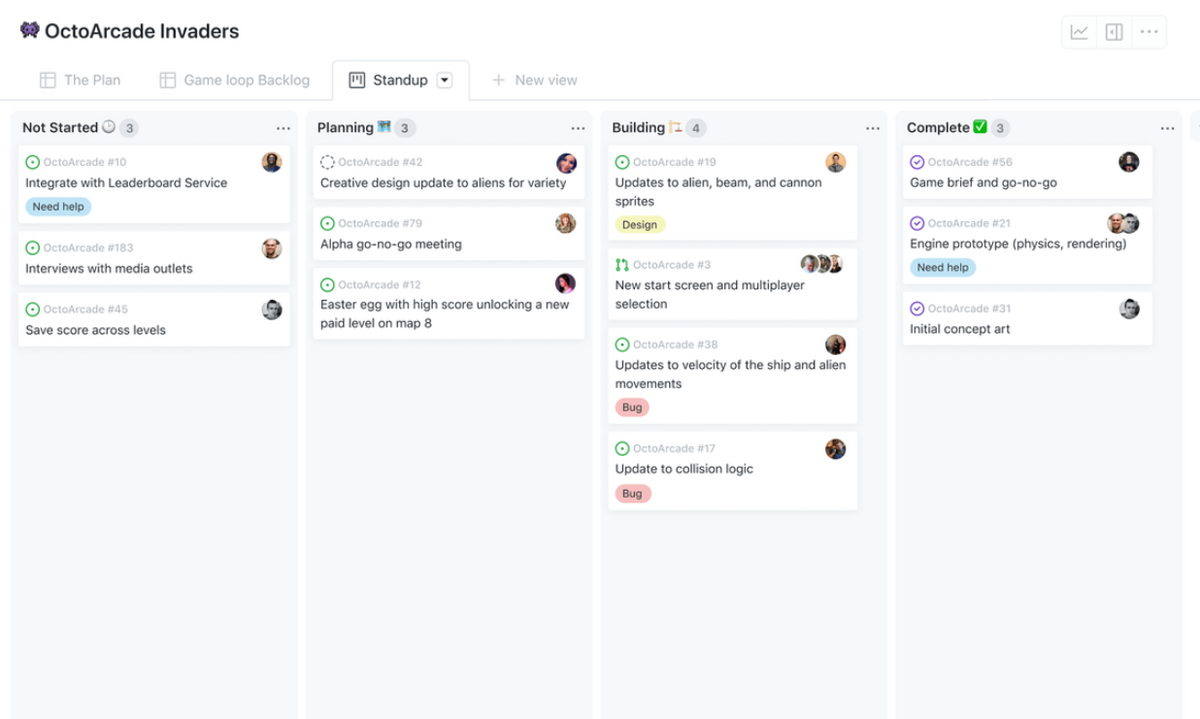
Many developers will know how to appreciate this built-in feature because it allows them to track issues not only within the Issues themselves but across the entirety of the GitHub ecosystem.
What precisely does this entail, and what makes the feature so interesting?
Well, software development teams often resort to independent issue tracking tools that are external to where development happens or where developers operate.
For example, you may build and deploy code in one place and then, through the integration mechanisms, merge it with issue tracking tools.
That’s not the case here because all issue-tracking and development projects happen within the GitHub platform itself, interwoven with the help of GitHub Issues.
As a result, creating issues has never been easier, as stated on their website.
You can create an issue from a repository, an item in a task list, a note in a project, a comment in an issue or pull request, a specific line of code, or a URL query.
Pretty neat, don’t you think so?
The good news is that GitHub Issues is available in all three GitHub pricing plans (Free, Team, and Enterprise), so regardless of which subscription you select, you’ll be able to use this feature.
So, if you’re already utilizing GitHub for your software development projects, be sure to give this fantastic tool a whirl.
Jira
Undoubtedly, Jira stands as one of the most popular and widely adopted issue tracking tools in the world and one of the developers’ all-time favorites.
Not only does it exhibit extraordinary versatility when it comes to handling issues, but thanks to an extensive array of integrations with other tools, it further facilitates the entire issue tracking process.
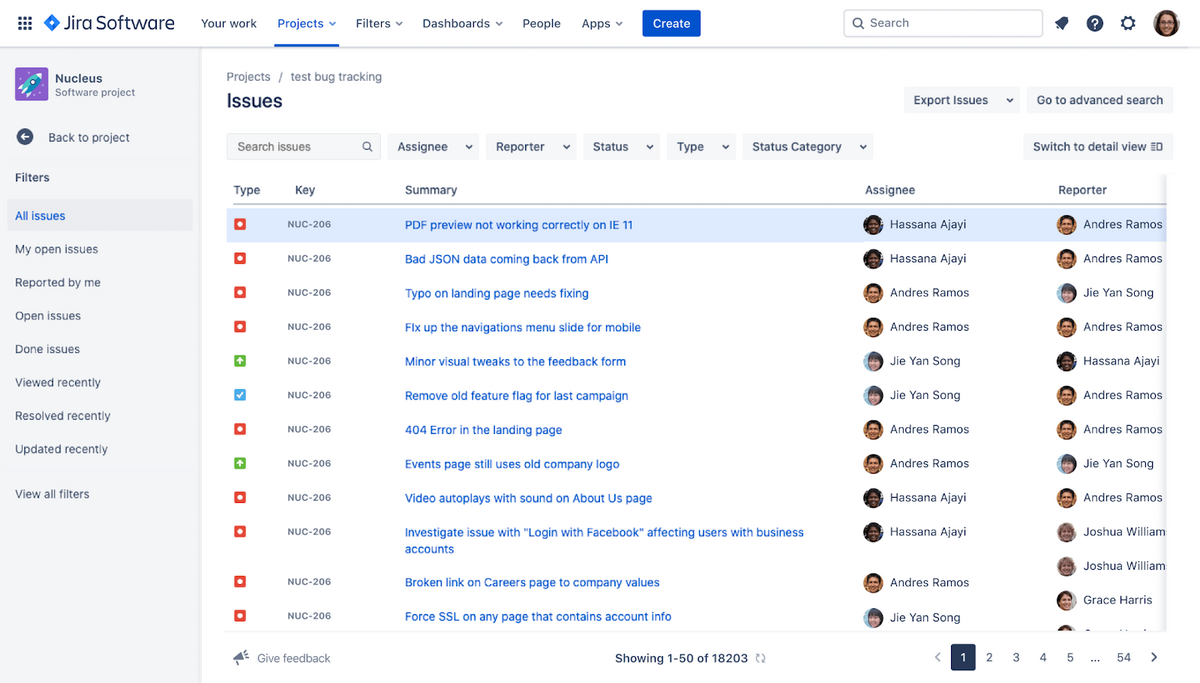
As one of the most customizable tools, it allows you to construct elaborate workflows for every project, no matter how meandering they may be.
This means that it isn’t confined only to the ordinary labels such as To do, In progress, and Done.
With Jira, you can forge more elaborate labels such as In planning, Ready for review, In peer review, and Waiting for QA, as you can see in the workflow below, or craft ones that are more aligned with your requirements.
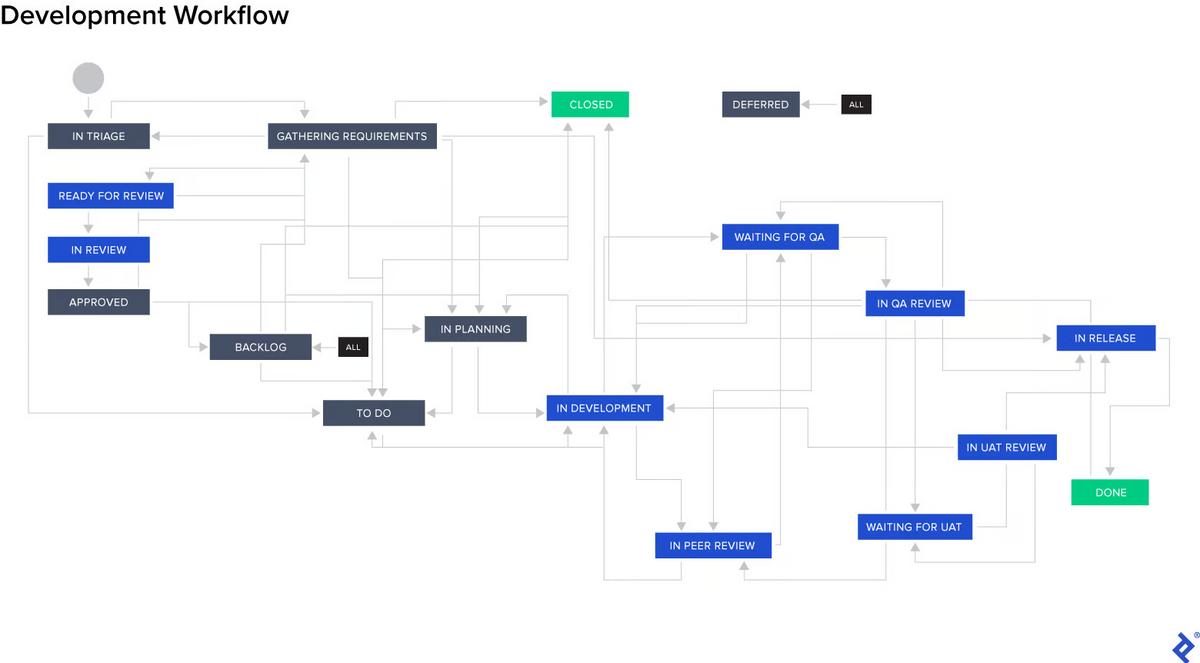
This grants you insight into every part of an issue’s life cycle, ensuring all team members remain in the loop about what’s completed, pending, upcoming, or planned.
Furthermore, you can establish links between issues, divide them into different categories (e.g., epic, bug, story, task, subtask), set up a notification system, and unlock a plethora of additional features.
One of Jira’s major strengths, however, is its ability to easily integrate with other tools and services such as Slack, Jenkins, BitBucket, LaunchDarkly, and even our very own Shake.
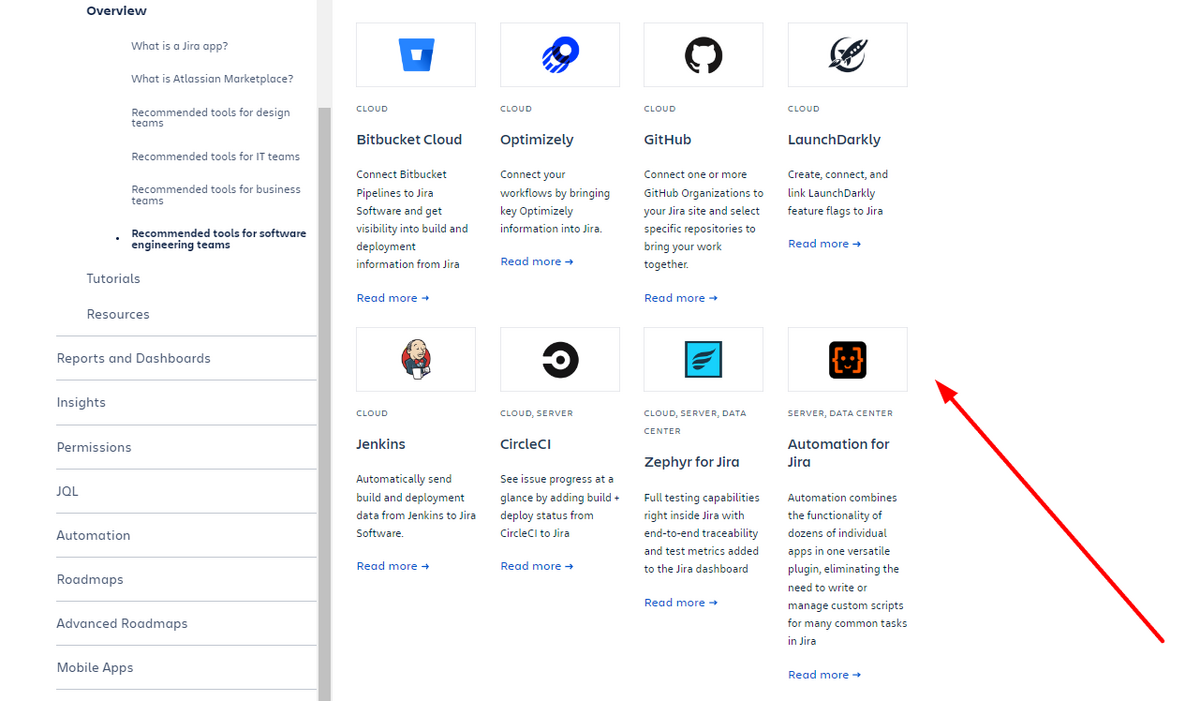
For instance, if you integrate Shake with Jira, the process of bug reporting and issue tracking becomes an easy feat.
When a user reports a bug and Shake generates a bug report, it’ll then automatically pop up in the Jira dashboard, where all stakeholders will be able to inspect it, track its progress, collaborate on it, and ultimately resolve it.
In other words, instead of manually creating a new issue in Jira and filling in all the required fields that go into a bug report, Shake does this automatically, harnessing the power of Jira’s integration.
In our humble opinion, this synergy between a quality bug reporting tool and Jira can do wonders when it comes to issue tracking.
However, keep in mind that some users mention Jira being complicated to use in their reviews.
So if this aspect weighs heavily in your decision-making process, keep an eye on the next tool on our list.
Linear
Although Linear is not as widely-known as GitHub Issue or Jira, it has a slew of advantages up its sleeve worth your attention.
First and foremost, it allows you to seamlessly convert tasks into issues and then break down those issues into more manageable components.
This nifty functionality will provide you with better issue tracking capabilities, particularly if you’re grappling with large and intricate projects.
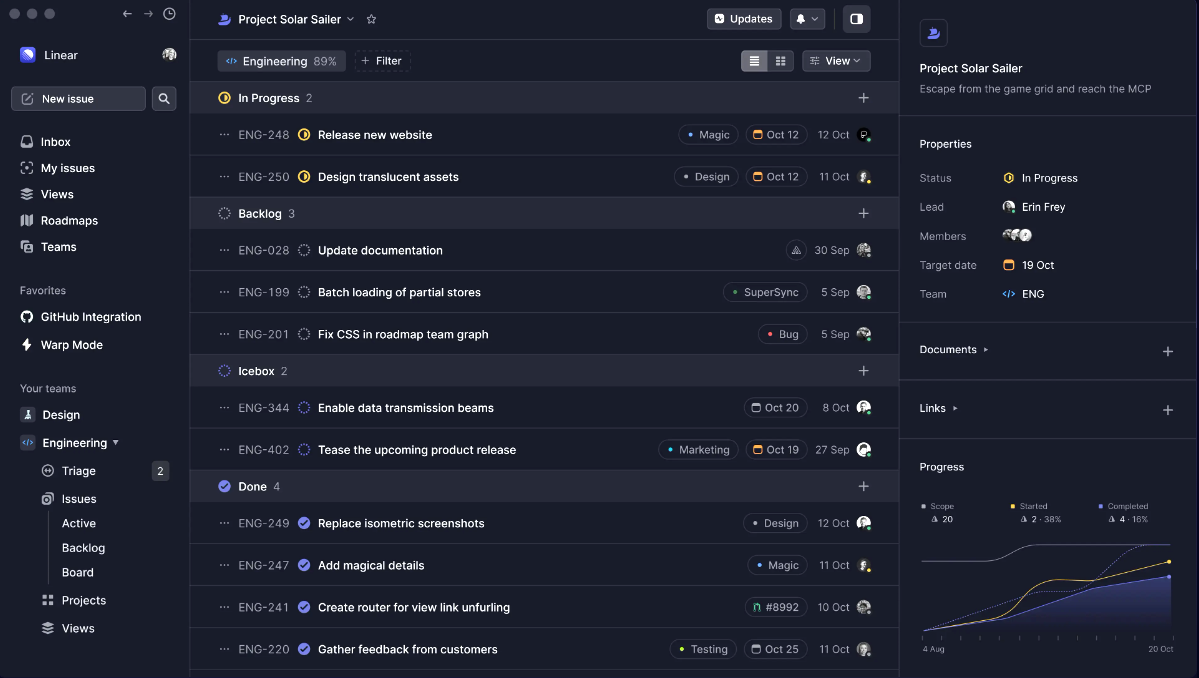
By allowing you to create custom workflows and apply filters and custom views, Linear will further facilitate handling issues.
What you may find interesting is the introduction of cycles, which are similar to agile sprints, except they aren’t tied to releases.
By dividing tasks and issues into cycles, you’ll have a much better overview of the progress your team is making and unlock more detailed insights into various aspects, as shown below.
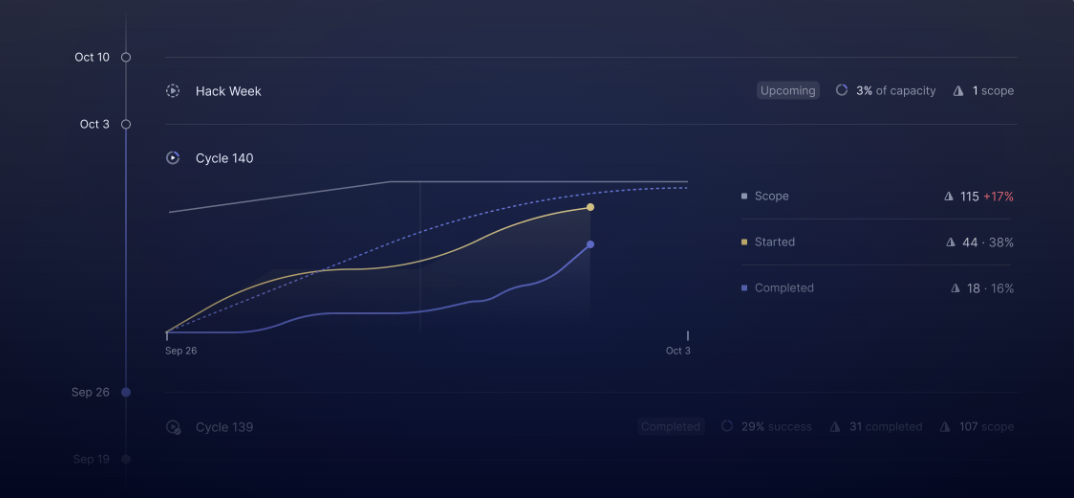
For instance, you can discern how long it takes the team to tackle complex problems and optimize project scheduling accordingly.
A neat feature is also its keyboard-driven interface, which allows you to use shortcuts for nearly any action you can think of and basically fly through tasks.
Regarding pricing, Linear offers a free plan that allows you to explore the intricacies of this tool and assess if it includes all the features you need.
If you’re ready to elevate your game, you have three subscription-based plans at your disposal. The cost scales based on the number of users, starting at $8 per user per month.
All in all, Linear is a modern and handy issue tracker tool that, while it may not bask in the same level of limelight as some of its counterparts, still encompasses all the essential characteristics you would expect from an exceptional issue tracking tool.
Mantis Bug Tracker
Everyone working in the software development field has probably heard of the tool MantisBT.
Founded back in 2002, it’s one of the pioneers in issue tracking, and the reason for its enduring success can be attributed to the fact that it’s free and open source, making it the go-to option for numerous development teams.

Moreover, it’s extremely easy to install, and available on many devices and platforms, so that even beginners and non-technical users quickly learn the ropes of its use.
Once you start using it, you’ll probably notice that the user interface is somewhat outdated compared to its competitors.
One reviewer vividly described it with the following words: “Ugly but free and works.”
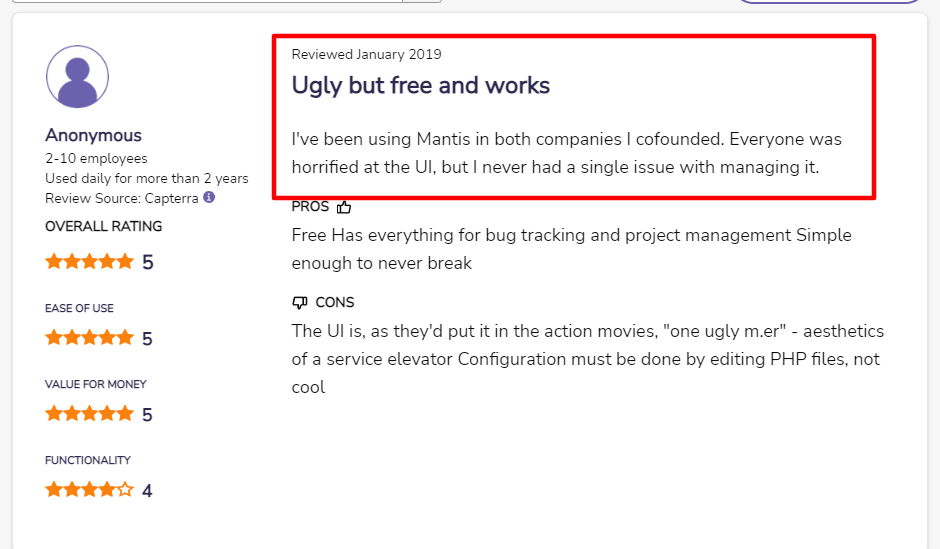
Although the interface truly is somewhat rudimentary, all the features of a quality issue tracker are present here, so once you start using it, it’s likely to become one of your favorite tools.
As you can see in the image below, with MantisBT you can track issues, report an issue, inspect change logs and roadmaps, and the My View section will grant you insight into issues assigned to you so you can keep an eye on their progress.
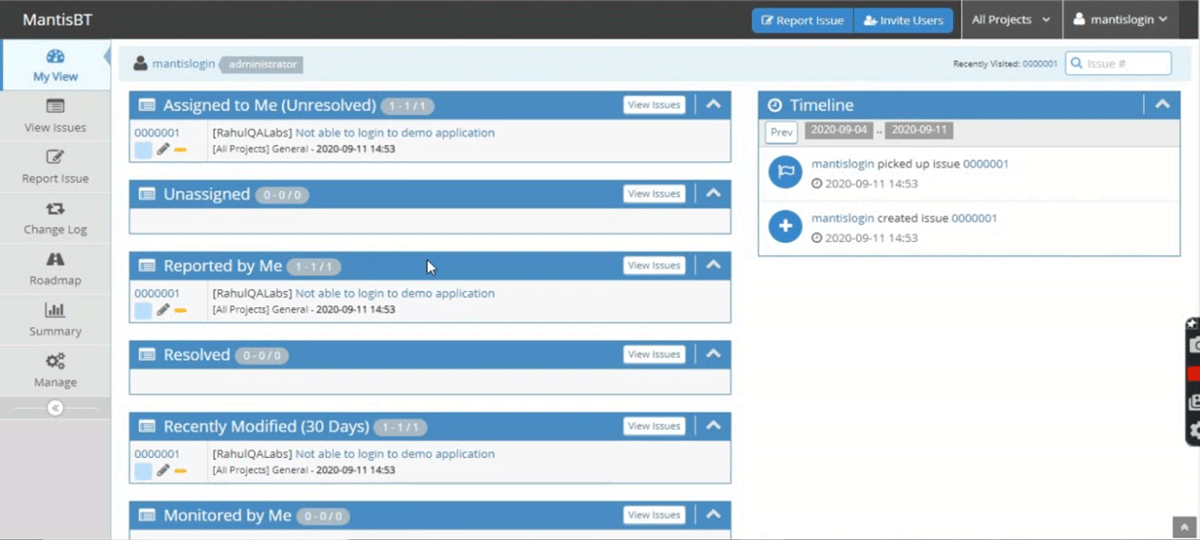
The tool also has an open-source community where you can ask questions if you encounter any problems. It generously offers support for multiple languages and allows you to add custom fields to any of your issues.
Although MantisBT is free, there is also a paid version if you want even more advanced options.
However, the free version has been in circulation for over twenty years, which signifies that it has been upgraded, refined, and improved over the years.
This means that it will most certainly be able to meet your bug tracking needs.
Keep in mind that MantisBT is an open-source tool, and, as is the case with all such tools, burdened with the possibility of security breaches.
Nevertheless, it’s still an excellent tool worth taking into consideration.
Shortcut
Shortcut, formerly known as Clubhouse, is an agile project management tool that also has issue tracking capabilities.
Designed as an alternative to tools such as Jira and GitHub Issues, it boasts ambitious features and combines everything you need from an issue tracker in a single product.
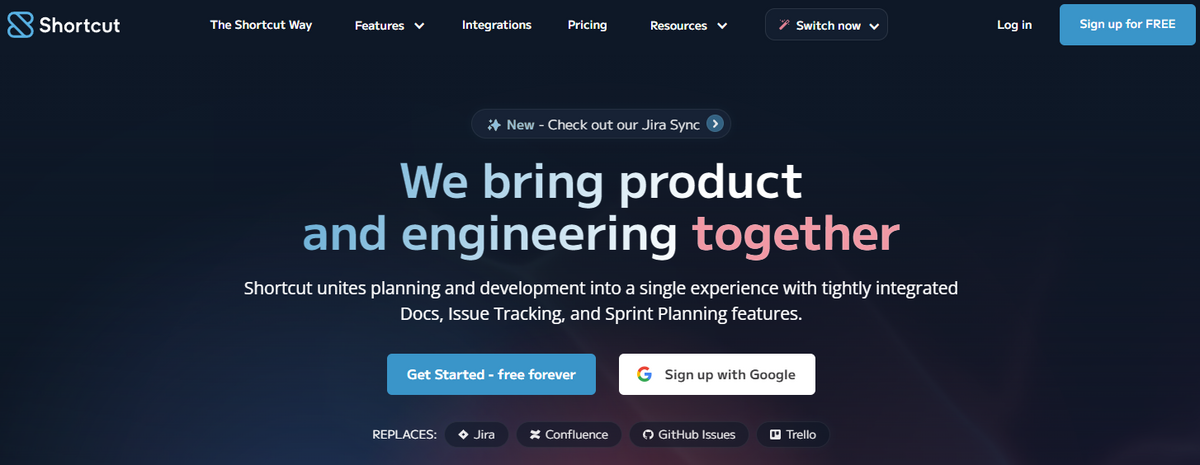
However, while Jira and GitHub Issues tend to cater more to the technical crowd, meaning that they are better suited for developers than cross-functional teams, Shortcut was designed with user-friendliness and accessibility in mind.
In other words, it’s flexible enough that even those who shy away from lines of code can use it.
With Shortcut, you can track all of your issues, plan sprints, visualize progress in Kanban boards or table view, drag and drop issues from the do column to the done status, assign tasks to team members, comment on issues, and much more.
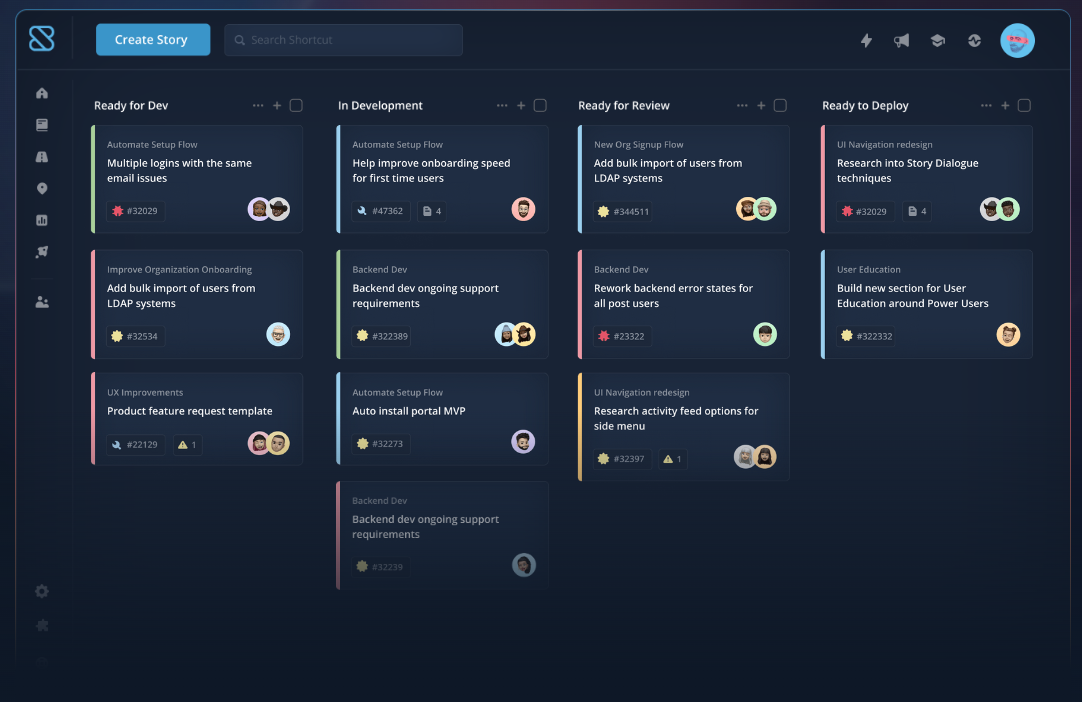
Moreover, the tool offers markdown options, keyboard shortcuts, integrations with other tools, and an API so that you can extend its functionality in accordance with your requirements.
There is one downside, though, as a lack of templates may hinder the onboarding process for new users.
As for its pricing structure, Shortcut offers one free and three subscription-based tiers, starting at $8.50 per user per month, which can accommodate teams of different sizes and budgets.
All in all, Shortcut can be an excellent tool for your issue-squashing efforts, especially if you need a flexible option that all team members, from coding experts to those who prefer to stay away from the technicalities, can partake in.
Tara
Tara is another issue tracker on our list that you can use to keep track of the bugs, crashes, defects, and other imperfections in your app.
It boasts speed and accuracy, using machine learning to identify and predict tasks that need to be handled, anticipate timelines for executing projects, monitor the progress of a project, and track issues.
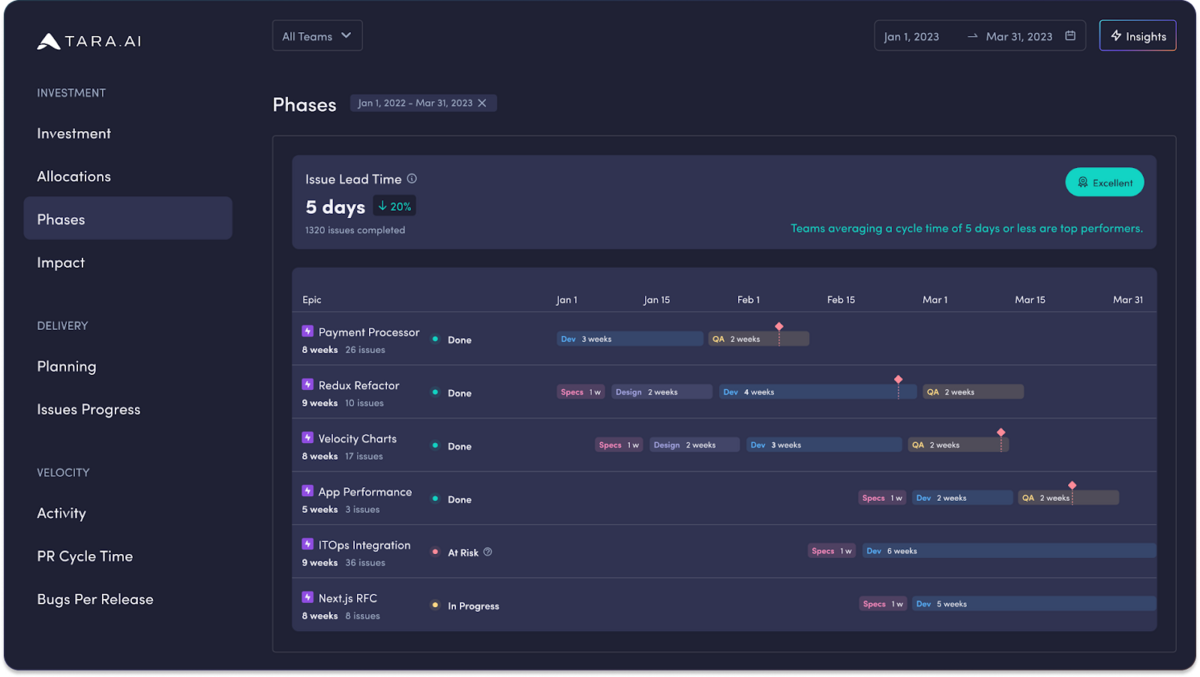
In other words, AI has made a grand entrance into software development planning, monitoring, and executing projects with this tool.
This is possible because it uses intelligent and predictive analytics based on what its engine has combed through across millions of open-source repositories and software projects across the web.
Thanks to this, users can promptly create tasks and timelines for project builds.
You can also sync your issues from GitHub and connect issue tracking in Tara with Git version control.
This way, your issues will automatically appear on Tara’s dashboard, where all stakeholders can see them in one place.
Although Tara AI is not predominantly an issue tracker, on account of the smart features this tool offers, you should definitely consider it for your bug tracking efforts.
The pricing is also straightforward.

You have a free plan and three paid plans that vary in the features they offer.
And you can sign up for a free trial or demo for all these plans to see how they suit you before making a purchase.
Zoho BugTracker
Last but not least, there is Zoho BugTracker, a top-notch issue tracker that will meet and exceed your expectations when it comes to tracking defects within your app.
If you look at the image below, you’ll notice the interface is sleek, intuitive, and simple, meaning you won’t have any problems tracking defects and squashing those annoying imperfections that have infiltrated your code.
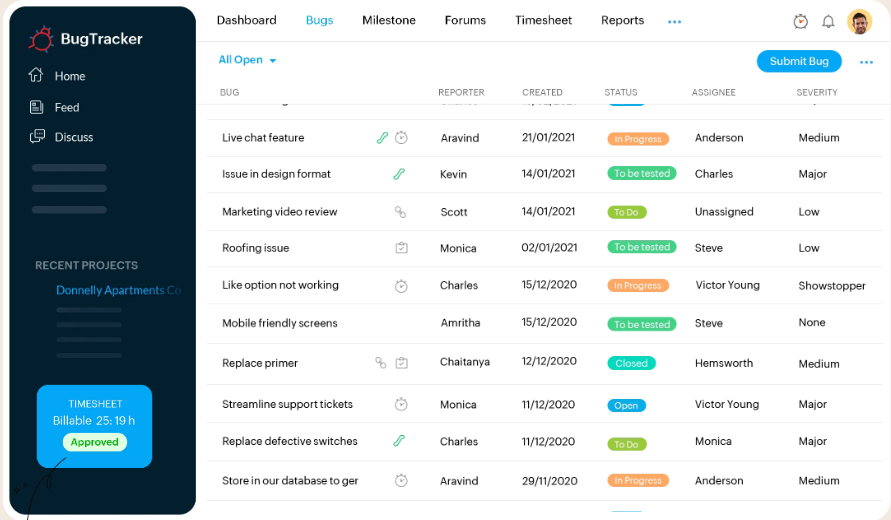
Prioritizing issues is important in any business, as it allows you to focus on pressing problems head-on and reserve the less important ones for a later date.
This tool has got your back on this front by allowing you to categorize issues based on their severity and impact.

Very handy for handling user feedback. CTOs, devs, testers – rejoice.
Additionally, you can set it up to send you alerts when impending deadlines are approaching and to share timely updates with your team so that everyone is up to date regarding eliminating any hindrances that may arise.
The bug status reports presented in visually appealing pie charts constitute another neat feature.
As shown in the image below, you can easily see who is assigned to resolving a specific issue in an app, the number of open and closed bugs, and so on.
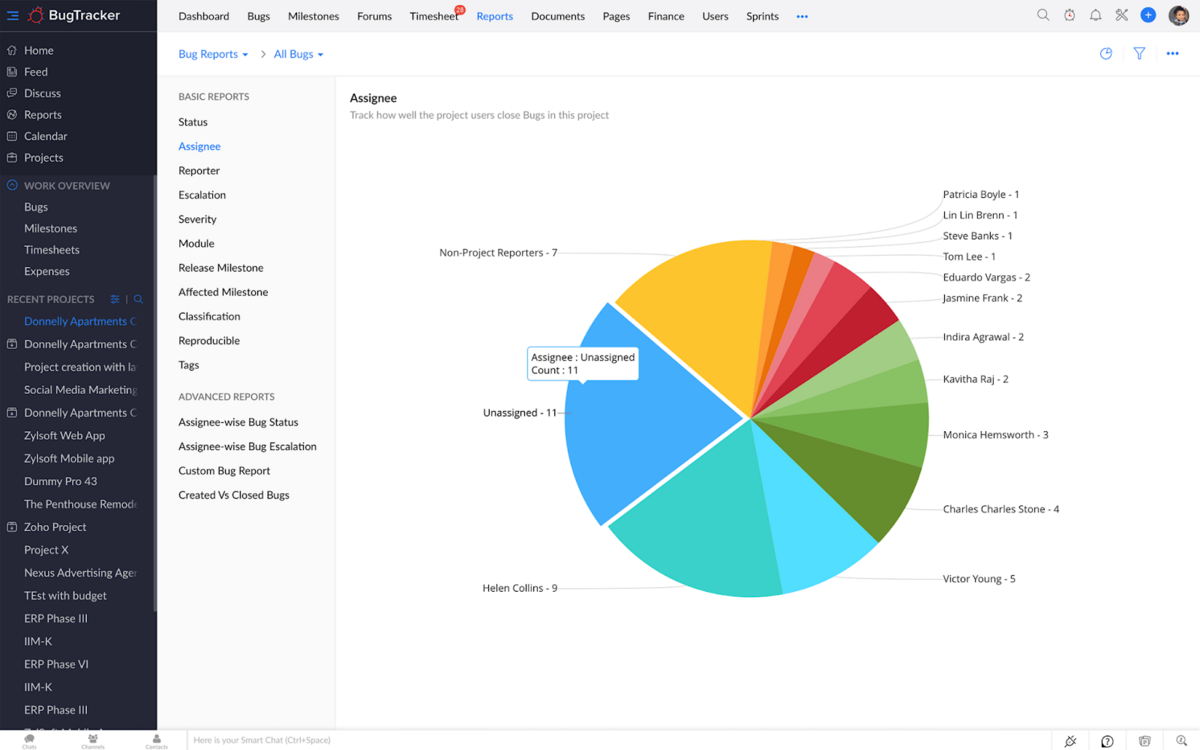
This way, you’ll know exactly where you stand in your bug-busting efforts, and you’ll be able to plan your workflow with pinpoint accuracy.
The pricing plans are friendly to your wallet, even for teams with tight budgets, and there is a free plan available that you can use until you start working on multiple projects.
All in all, Zoho BugTracker is an excellent choice for anyone in need of a specialized tool exclusively for handling bugs, which is budget-friendly, effective, and easy to use.
Conclusion
All nine tools we’ve showcased in this article have unique capabilities, a proven track record, and an impressive following of satisfied users.
Consequently, when it comes to you selecting the perfect tool for your needs, their subtle nuances will likely sway your decision.
Hopefully, we were able to shed some light on these differentiations, enabling you to narrow down your options and pinpoint the ideal match for you and your team.





